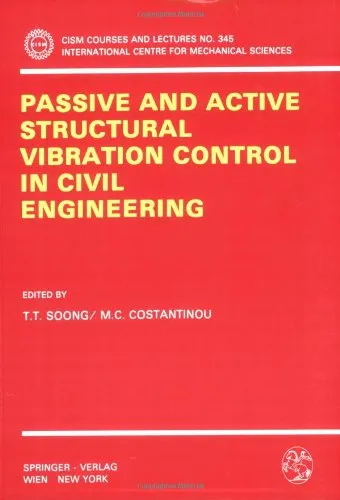Passive and Active Structural Vibration Control in Civil Engineering (CISM International Centre for Mechanical Sciences)
4.5
بر اساس نظر کاربران

شما میتونید سوالاتتون در باره کتاب رو از هوش مصنوعیش بعد از ورود بپرسید
هر دانلود یا پرسش از هوش مصنوعی 2 امتیاز لازم دارد، برای بدست آوردن امتیاز رایگان، به صفحه ی راهنمای امتیازات سر بزنید و یک سری کار ارزشمند انجام بدینمعرفی جامع کتاب "Passive and Active Structural Vibration Control in Civil Engineering"
کتاب Passive and Active Structural Vibration Control in Civil Engineering نوشته "T.T. Soong" و "M.C. Costantinou"، یکی از جامعترین و معتبرترین منابع در زمینه مهندسی عمران و کنترل لرزهای سازهها محسوب میشود. این کتاب به بررسی جنبههای نظری، فنی، و عملی کنترل لرزش سازهها در ساختمانهای مدرن پرداخته و راهکارهایی برای بهبود مقاومت سازهها در برابر نیروهای لرزهای، باد، و سایر تحریکات خارجی ارائه میدهد.
این کتاب جزء مجموعه علمی CISM International Centre for Mechanical Sciences است که هدف آن ترویج پژوهشهای پیشرفته در زمینه علوم مکانیک و مهندسی میباشد. نویسندگان تلاش کردهاند تا از دیدگاه میانرشتهای به موضوع نگاه کنند و مفاهیم بنیادین را با جزئیات عملی ترکیب نمایند.
خلاصهای جامع از کتاب
این کتاب شامل دو بخش اصلی است: کنترل لرزش غیرفعال (Passive Control) و کنترل فعال (Active Control). در بخش اول، مفاهیمی مانند استفاده از Dampers، Base Isolation Systems، و Tuned Mass Dampers مورد بررسی قرار گرفتهاند. این روشها بر کاهش اثرات لرزهای بدون نیاز به انرژی خارجی تمرکز دارند. در مقابل، بخش دوم به تکنیکهای کنترل فعال پرداخته که شامل استفاده از سیستمهای هوشمند و ترکیب الگوریتمهای پیچیده برای مدیریت لرزش به صورت بلادرنگ است.
کتاب با ارائه مثالهای عملی و مطالعات موردی از پروژههای اجرایی در سراسر جهان، به خوانندهها کمک میکند تا مفاهیم را درک کرده و آنها را در پروژههای خود اعمال کنند. بحثهای تئوریک با استفاده از Models و Diagrams توضیح داده شدهاند و هر فصل با مسائل کاربردی به پایان میرسد تا یادگیری خوانندهها تقویت شود.
نکات کلیدی کتاب
- آشنایی با اصول پایهای کنترل لرزش و مبانی طراحی سیستمهای مقاوم در برابر زلزله.
- توضیحات جامع درباره تفاوتهای روشهای غیرفعال و فعال.
- معرفی تکنولوژیهای پیشرفته مانند Active Mass Damper و Smart Sensors.
- ارائه استراتژیهای کاربردی برای مهندسان عمران و طراحان سازه.
- بررسی مطالعات موردی از پروژههای اجرایی در شرایط مختلف اقلیمی.
جملات معروف از کتاب
"در دنیای مدرن که همیشه با خطر بلایای طبیعی روبرو هستیم، کنترل لرزش سازهها، نه تنها یک انتخاب بلکه یک ضرورت است."
"کنترل لرزهای سازهها باید یک رویکرد میانرشتهای را شامل شود؛ چرا که علم، فناوری، و طراحی همه نقش حیاتی در حفاظت از زندگی و داراییها ایفا میکنند."
چرا این کتاب مهم است؟
این کتاب به دلیل رویکرد جامع و تخصصی خود به یکی از منابع اصلی در زمینه کنترل لرزش سازهها تبدیل شده است. با افزایش نگرانیهای جهانی نسبت به زلزلهها و تغییرات آب و هوایی، مهندسان عمران بیشتر به دنبال راهکارهایی برای بهبود مقاومت سازهها هستند. این کتاب نه تنها دانش نظری عمیقی ارائه میدهد، بلکه ابزارهایی برای پیادهسازی عملی راهکارهای کنترل لرزش فراهم میکند.
اهمیت کتاب همچنین در ارائه تکنولوژیهای نوینی است که میتوانند به طور اثربخش در طراحی ساختمانها و سازههای عمرانی به کار روند. از این رو، برای مهندسان عمران، طراحان سازه، و پژوهشگران، این کتاب به عنوان یک منبع ارزشمند و بنیادین شناخته میشود.
Introduction to Passive and Active Structural Vibration Control in Civil Engineering
Structural vibration control has emerged as a critical area in civil engineering, with advancements in technology enabling more effective strategies for mitigating the adverse effects of vibrations on large-scale structures. The book 'Passive and Active Structural Vibration Control in Civil Engineering' comprehensively explores the methods, principles, and applications of both passive and active approaches to vibration control. Authored by T.T. Soong and M.C. Costantinou, this work combines engineering theory with practical applications to serve as an essential resource for researchers, engineers, and students alike.
Detailed Summary of the Book
In this book, the authors delve into the fundamental principles of structural vibration control, dividing their analysis into passive and active control systems. Passive control systems, characterized by their simplicity and reliability, are thoroughly examined. These systems include base isolators, tuned mass dampers, and viscous dampers, among others, which function by dissipating energy or altering the dynamics of the structure to minimize vibrations. Active control systems, on the other hand, focus on automated mechanisms that actively respond to dynamic forces, making use of advanced sensors, actuators, and control algorithms.
The book provides an in-depth look at theoretical frameworks, mathematical modeling, and experimental data, showcasing the real-world efficacy of these systems. Practical implementations are described through case studies, ranging from high-rise buildings to bridges, highlighting the importance of vibration control in ensuring structural safety and performance. Additionally, the authors discuss emerging trends, such as semi-active and hybrid systems, which leverage the benefits of both passive and active mechanisms.
Key Takeaways
- An extensive understanding of passive vibration control systems and their applications in civil engineering.
- A deep dive into active vibration control mechanisms, including technological innovations in sensors and actuators.
- Critical analysis of hybrid and semi-active systems for optimizing structural vibration control strategies.
- Real-world applications and case studies of vibration control implementation in major civil engineering projects.
- Insights into the future of vibration control technology and its impact on civil engineering design.
Famous Quotes from the Book
"Vibration control is not merely about countering dynamic forces but about enabling structures to adapt and endure in the face of uncertainty."
"Passive systems represent the elegance of simplicity, while active systems showcase the ingenuity of adaptation."
"The future of structural vibration control lies in hybrid approaches that balance precision, efficiency, and cost-effectiveness."
Why This Book Matters
The importance of vibration control in civil engineering cannot be overstated, as uncontrolled vibrations can compromise the structural integrity, safety, and serviceability of buildings and infrastructure. This book serves as a cornerstone for understanding the complexities of vibration control from both theoretical and practical perspectives. By offering a thorough and scholarly treatment of the subject, it bridges the gap between academia and real-world applications.
Engineers can apply the principles presented in this book to design safer and more resilient structures, while researchers can leverage it as a foundation for further innovation in the field. It also serves as an excellent educational resource for students preparing to enter the dynamic world of civil engineering, providing them with tools to tackle vibration-related challenges effectively.
The relevance of this book extends beyond the immediate scope of civil engineering, offering insights into interdisciplinary applications such as mechanical and aerospace engineering. Ultimately, 'Passive and Active Structural Vibration Control in Civil Engineering' equips readers with essential knowledge and foresight, ensuring they are well-prepared for the evolving demands of modern infrastructure development.
دانلود رایگان مستقیم
شما میتونید سوالاتتون در باره کتاب رو از هوش مصنوعیش بعد از ورود بپرسید
دسترسی به کتابها از طریق پلتفرمهای قانونی و کتابخانههای عمومی نه تنها از حقوق نویسندگان و ناشران حمایت میکند، بلکه به پایداری فرهنگ کتابخوانی نیز کمک میرساند. پیش از دانلود، لحظهای به بررسی این گزینهها فکر کنید.
این کتاب رو در پلتفرم های دیگه ببینید
WorldCat به شما کمک میکنه تا کتاب ها رو در کتابخانه های سراسر دنیا پیدا کنید
امتیازها، نظرات تخصصی و صحبت ها درباره کتاب را در Goodreads ببینید
کتابهای کمیاب یا دست دوم را در AbeBooks پیدا کنید و بخرید
1138
بازدید4.5
امتیاز50
نظر98%
رضایتنظرات:
4.5
بر اساس 0 نظر کاربران
"کیفیت چاپ عالی بود، خیلی راضیام"
Questions & Answers
Ask questions about this book or help others by answering
No questions yet. Be the first to ask!


